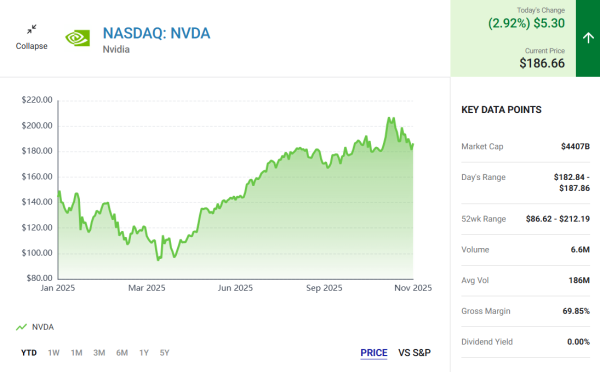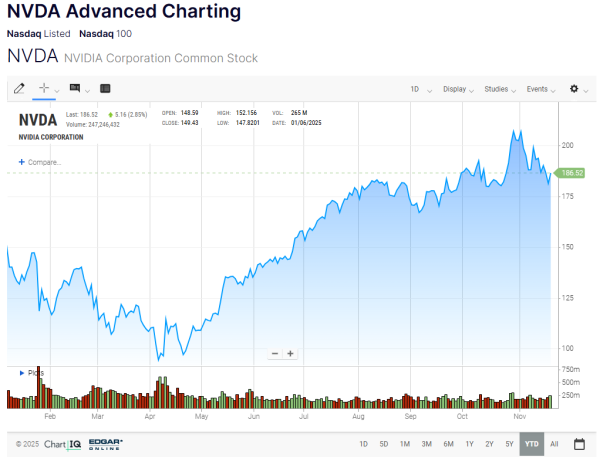In a week when whispers of an AI bubble drifted nervously through trading desks, Nvidia detonated those doubts with an earnings blast loud enough to ripple across the entire tech sector.
Brokers from LFtrade, describe the atmosphere as “electric” as Nvidia’s numbers rolled in, transforming market anxiety into renewed conviction. What many feared might be the first cracks in AI’s foundation instead revealed a structure growing stronger, deeper, and more indispensable than ever..
Record Revenue Signals Relentless AI Demand
Nvidia’s fiscal third quarter of 2026 stunned the market with record revenue of $57 billion, representing a 62% jump year over year and a 22% increase sequentially. The vast majority of this came from data center operations, which soared to $51.2 billion, marking a 66% increase from the same period last year.
For brokers analyzing the report, these figures confirm that AI spending remains not only strong but accelerating. The intense demand for training and inference workloads continues to drive corporations, governments, and research institutions into a global race for compute capacity.
Even more compelling for investors is Nvidia’s profitability. The company posted gross margins of 73.4% and net income of $31.9 billion, up 65% year over year. Earnings per share climbed 67% to $1.30, reinforcing Nvidia’s dominance in high-margin AI infrastructure.

Blackwell Frenzy and GPU Shortages
CEO Jensen Huang described the environment with a level of enthusiasm that echoed across the financial sector. Huang stated that “Blackwell sales are off the charts, and cloud GPUs are sold out”, emphasizing that compute demand continues to compound rapidly.
Brokers reviewing the commentary point to several implications:
- The Blackwell platform, Nvidia’s latest generation of AI chips, is being adopted faster than previous architectures.
- Cloud providers and large-scale AI labs are absorbing Nvidia’s supply as soon as it becomes available.
- A virtuous cycle is forming, where expanding AI adoption fuels more demand for computers, which in turn accelerates innovation.
In other words, many expected a slowdown. Nvidia delivered the opposite.
Fourth Quarter Guidance Fuels Further Optimism
Looking ahead, Nvidia forecasts $65 billion in revenue for Q4. The company also expects margins to strengthen further, projecting a range between 74.8% and 75%. For brokers, this number is crucial. It directly contradicts the argument that AI hardware demand is peaking or flattening.
Nvidia’s ability to raise guidance in an already record-setting year underscores two vital themes:
- AI infrastructure spending is still in an expansion phase.
- Competitors have not meaningfully disrupted Nvidia’s lead.
Strategic Partnerships Reinforce Long-Term Trajectory
Nvidia’s results are backed by high-profile and long-term partnerships across the AI landscape. The company is already powering more than 10 gigawatts of OpenAI’s compute footprint and has signed a new agreement with Anthropic to build at least 1 gigawatt of additional processing capacity.
Major cloud platforms are also deeply embedded in Nvidia’s ecosystem. These include Google Cloud, Microsoft Azure, Oracle, and xAI. Each partnership expands the global infrastructure required to support the rapidly scaling AI market.
For brokers, the strategic significance is clear. These partnerships are not short-term boosts but multi-year commitments that create recurring infrastructure demand. The major AI firms all lean heavily on Nvidia’s chips, and despite meaningful investment in alternative architectures, none have approached the performance or energy efficiency required to slow Nvidia’s dominance.

Market Reaction and Sector Trends
Nvidia’s stock surged 4% in after-hours trading following the earnings release. Other AI-linked equities rallied in sympathy. Advanced Micro Devices climbed 3%, Broadcom added 2%, and Palantir rose 2.5%.
This reaction reflects renewed confidence in the AI sector after several weeks of turbulence. The technology sector had been flat over the last month despite a strong start to the year. Brokers note that Nvidia’s performance may be the catalyst investors needed to reenter AI positions before the year closes.
What This Means for Investors
The fears surrounding an AI bubble centered on the idea that valuations had run too far ahead of fundamentals. Nvidia’s earnings provided the opposite evidence. The fundamentals are catching up to, and in many cases surpassing, market expectations.
Key takeaways for investors include:
- AI demand remains exponential, not linear.
- Data center investments continue to accelerate, powering long-term revenue opportunities.
- Nvidia’s margins and guidance suggest no near-term slowdown.
- Partnerships across major AI labs and cloud providers solidify future demand.
While valuations across the AI sector remain elevated, the earnings performance offers justification that these prices are supported by exceptional revenue and profit expansion.









